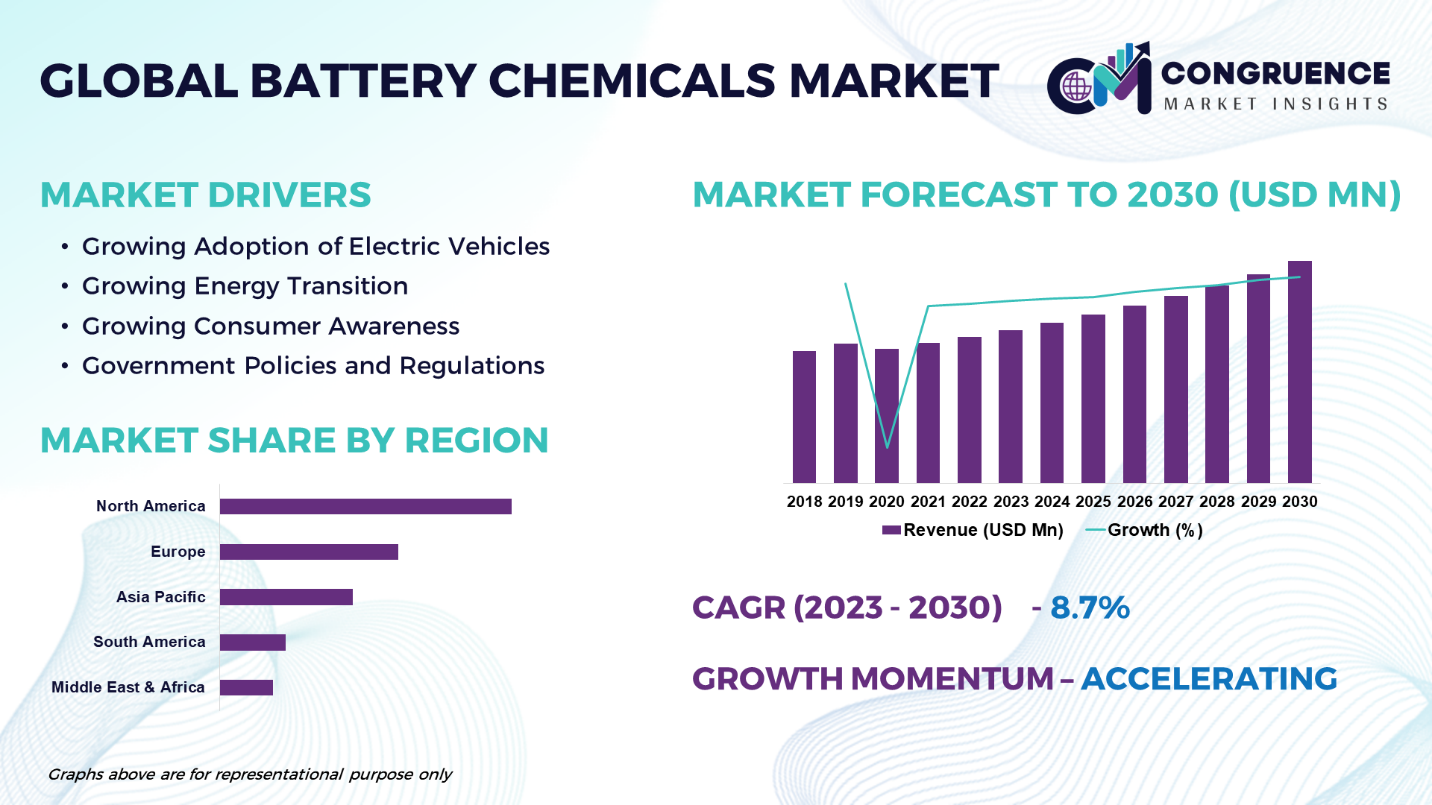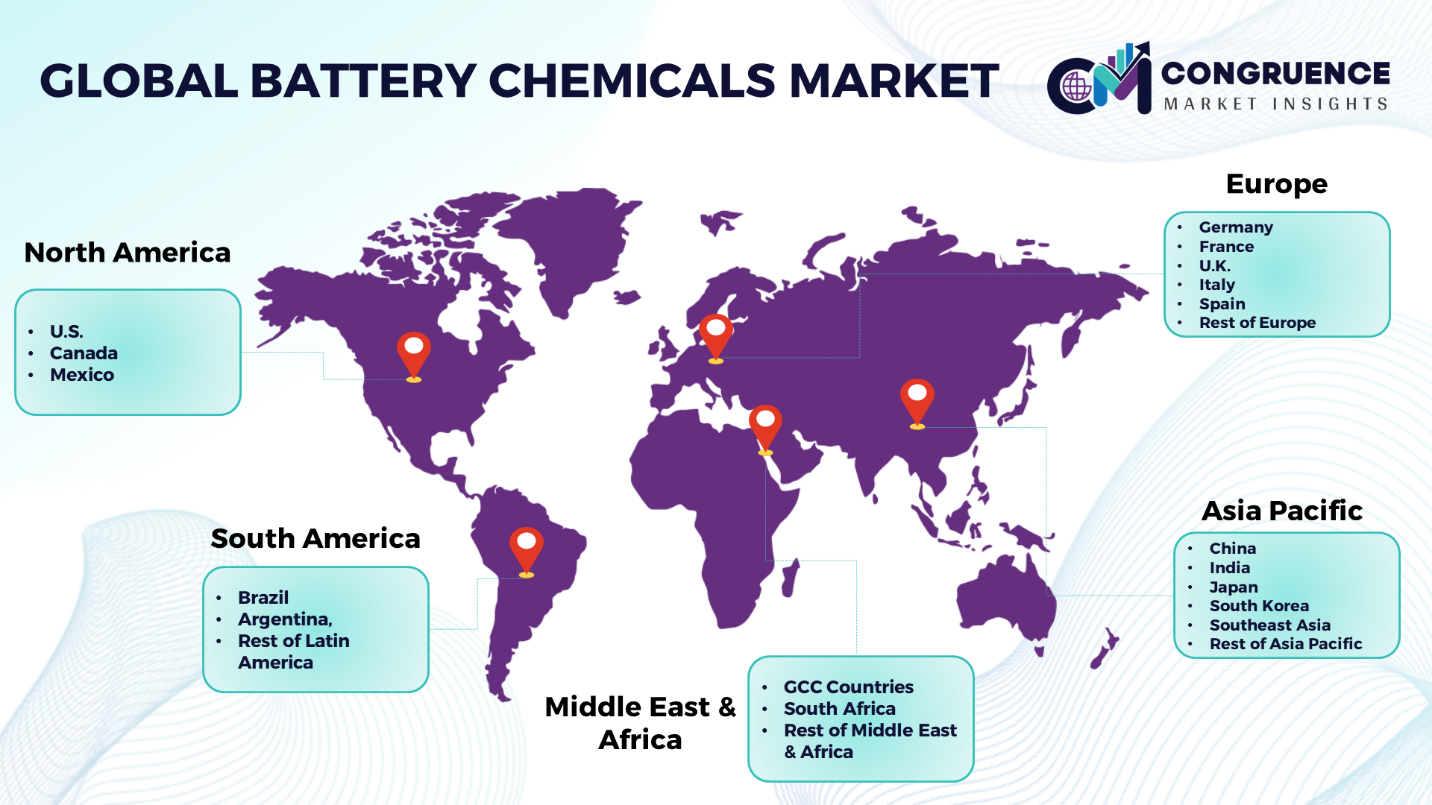Reports
The Global Battery Chemicals Market is expected to expand at a CAGR of 8.7% between 2023 and 2030. Battery chemicals are the fundamental components of batteries used across a wide range of industries, including automotive, construction, and electronics. The battery chemistry reflects the voltage and performance characteristics. Batteries are classified based on the specific chemistry of the materials contained within the batteries. Common battery chemistries include variations of lead, nickel, and lithium. Types of battery chemicals include cathode, anode, and electrolyte. The battery chemicals significantly impact the battery’s performance, cost, safety, and environmental impact, thereby choice of battery chemical is most crucial thing. Each battery employing different chemical compositions and materials. The market witnessed a significant growth during the recent years due to the substantial growth of the major end-use applications industries including automotive, consumer electronics, energy storage systems, household appliances, security & monitoring systems, and utilities and power backup. The market is influenced by factors such as growing adoption of electric vehicles, growing energy transition, growing consumer awareness, and government policies and regulations.

Battery Chemicals Market Major Driving Forces
Growing Adoption of Electric Vehicles: The increasing adoption of electric vehicles is the major driver of the battery chemicals market. Electric vehicles mostly rely on lithium-ion batteries, contributing the demand for essential battery chemicals such as lithium, cobalt, and nickel.
Growing Energy Transition: The growing need to reduce carbon emission and shift towards greener energy sources is driving the global energy transition, which is significantly drives the market of battery chemicals. This transition required increased energy storage capacity, which batteries provide.
Growing Consumer Awareness: Consumers are becoming more aware of environmental concerns and benefits of clean energy technologies, which significantly drives the battery chemicals market growth. Consumers are increasingly prioritizing electric vehicles, renewable energy solutions, and portable electronic devices with longer-lasting batteries.
Government Policies and Regulations: Increasing concerns about climate change and air pollution are promoting governments across the world to establish policies and regulations for clean energy solutions. The initiatives resulting in the adoption of electric vehicles, renewable energy storage, and sustainable technologies, contributing to the market growth.
Battery Chemicals Market Key Opportunities
Advancements in Battery Technology: Ongoing research and development efforts in battery technology creates an opportunity for innovations. Innovations in battery technologies such as higher energy density, faster charging, and enhanced overall battery performance. These advancements make batteries more effective for several applications, propelling the market demand for their chemical components.
Recycling Technologies: The efforts for the development of efficient recycling technologies for batteries is expected to offer a significant opportunity for market expansion. Sustainable practices for reusing and recovering battery chemicals contribute to resource conservation and address environmental concerns. Companies are exploring methods to recover valuable materials from used batteries to reduce environmental impact and ensuring sustainability.
Growth in Consumer Electronics: The rapid expansion of the consumer electronics industry including smartphones, laptops, and wearable devices is anticipated to create an opportunity for market growth. These electronic devices require compact and high-performance batteries, which influences the demand for battery chemicals.
Battery Chemicals Market Key Trends
· The growing demand for energy storage systems in power generation and utilities is propelling the global market for battery chemicals
· Innovations in cathode materials, including solid-state cathodes, lithium iron phosphate, and lithium nickel manganese cobalt oxide are enhancing lithium-ion battery performance
· Growing preference for solid-state batteries which are transformative technology in the battery chemicals market, solid conductive materials offer advantage such as higher energy density, faster charging, and improved safety
· Major players are increasingly incorporating novel materials into the manufacturing of lithium-ion batteries in order to reduce production costs
· Ongoing efforts to establish efficient battery recycling technologies are on the rise, companies are exploring methods to recover valuable materials from used batteries
· The growing shift towards sustainable and ethical sourcing of raw materials to ensure responsible mining practices and transparent supply chains
· The growing focus on renewable energy boosting the demand for high-performance, longer life cycle, backup power, and improved performance

Market Competition Landscape
The global battery chemicals market is characterized by high degree of competition among a large number of manufacturers. These major companies made a strategic investment in research and development to enhance the production process and improve battery performance. Key players in the battery chemicals market engage in strategies aimed at gaining a competitive edge. These strategies include product innovation, design differentiation, and the incorporation of sustainable and eco-friendly materials to meet evolving consumer preferences. Moreover, prominent players focusing on cost reduction and improved performance in this competitive market to strengthen position in the market. Established brands leverage their reputation for quality and reliability to maintain market share, while newer entrants focus on disruptive innovations and unique selling propositions.
Key players in the global battery chemicals market implement various organic and inorganic strategies to strengthen and improve their market positioning. Prominent players in the market include:
· Albemarle Corporation
· China Molybdenum Co. Ltd.
· Gan feng Lithium Co. Ltd.
· Livent Corporation
· Norlisk Nickel
· Sheritt International Corporation
· Umicore SA
· BASF SE
· SQM S.A.
· Glencore PLC
· Targray Technology International Inc.
· Teck Resources
· Tianqi Lithium
· Vale S.A.
· Cabot Corporation
· LG Energy Solution
|
Report Attribute/Metric |
Details |
|
Base Year |
2022 |
|
Forecast Period |
2023 – 2030 |
|
Historical Data |
2018 to 2022 |
|
Forecast Unit |
Value (US$ Mn) |
|
Key Report Deliverable |
Revenue Forecast, Growth Trends, Market Dynamics, Segmental Overview, Regional and Country-wise Analysis, Competition Landscape |
|
Segments Covered |
· By Chemical Type (Cathode, Anode, and Electrolyte) · By Battery Type (Lithium-ion Batteries, Lead-acid Batteries, Nickel Cadmium Batteries, Alkaline Batteries, and Others) · By End-use Industry (Automotive, Consumer Electronics, Energy Storage Systems, Household Appliances, Security & Monitoring Systems, and Others) |
|
Geographies Covered |
North America: U.S., Canada and Mexico Europe: Germany, France, U.K., Italy, Spain, and Rest of Europe Asia Pacific: China, India, Japan, South Korea, Southeast Asia, and Rest of Asia Pacific South America: Brazil, Argentina, and Rest of Latin America Middle East & Africa: GCC Countries, South Africa, and Rest of Middle East & Africa |
|
Key Players Analyzed |
Albemarle Corporation, China Molybdenum Co. Ltd.,Gan feng Lithium Co. Ltd.,Livent Corporation,Norlisk Nickel,Sheritt International Corporation,Umicore SA,BASF SE,SQM S.A.,Glencore PLC,Targray Technology International Inc.,Teck Resources,Tianqi Lithium,Vale S.A.,Cabot Corporation, and LG Energy Solution |
|
Customization & Pricing |
Available on Request (10% Customization is Free) |
